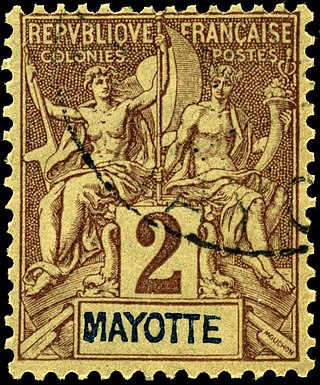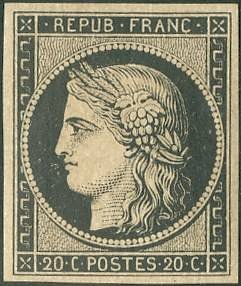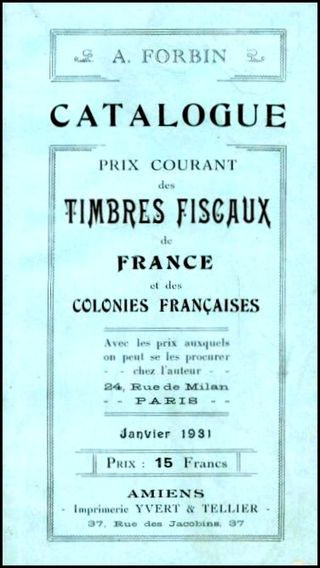
The evolution of the rate for sending a letter to France at the first weight level can be studied from 1848 to the present day.

The evolution of the rate for sending a letter to France at the first weight level can be studied from 1848 to the present day.
In 1848, the French Post Office launched the printing of a 20 centime stamp in black and a 1 franc stamp in red.
Between 1849 and 1920, the Post Office's rate for the first weight step was relatively stable between 10 and 40 centimes de franc for 15 grams.
In the interwar period, postal prices rose steadily from 25 centimes in 1920 to 1 franc in 1939. [1]
After the Second World War, the price of a letter weighing less than 20 grams rose from 3 francs in 1946 to 25 francs in 1959. [2]
With the new franc, the domestic rate rose from 25 centimes in 1960 to 40 centimes in 1969.
For some forty years, the price of a stamp for a letter weighing less than 20 grams remained stable, equivalent to 60 and 70 euro cents in 2022.
During the 1970s, the domestic rate for a 20-gram letter rose from 80 centimes to 1.40 francs in 1980.
Between 1983 and 2017, the priority rate increased by 3.06% per year. Since the changeover to the euro in 2001 and until 2017, the same rate has increased by an average of 3.91% per year. In comparison, between 1991 and 2014, inflation in France averaged 1.59% per year. [3]
It's worth noting: Fare increases did not keep pace with inflation in the 1980s. [4] Since then, increases have generally been higher than the rate of inflation.
From January 1, 2015, to December 31, 2018, rate increases are governed by a four-year agreement, which limits the increase to 3.5% on top of inflation. However, in October 2017, ARCEP authorized La Poste to override the initial agreement. [5]
In January 2017, La Poste explained that the highest increases of the 2010s were decided "to ensure the sustainability of the universal service in a context of declining mail volumes". [6] However, UFC denounced these increases, in the words of its president, who felt that they acted "as a repellent" and that they were precipitating the end of low value-added service. [7]

In 1984, Jean Fourastié, well known for his work on prices, productivity and technical progress, highlighted the value of having a vision of price trends free from currency variations by introducing the notions of current and constant prices. [9]
The current price is recorded in the current currency at a specific location and date. These are called nominal prices. The constant price is the price in real terms corrected for price changes relative to a base or reference date. [10] [11]
The table below does not refer to every year since 1983: percentage increases are calculated concerning the line immediately below and are therefore not necessarily annual increases.
| Date | up to 20g | ||
|---|---|---|---|
| Priority letter rate (red stamp) | Green letter rate (green stamp) | Ecopli rate (grey stamp) | |
| January 1, 2024. [12] | - | €1,29 / 8,46 FRF (+11,2%) | - |
| January 1, 2022. [13] [14] | €1,43 / 9,38 FRF (+11,7%) | €1,16 / 7,60 FRF (+7,4%) | €1,14 / 7,47 FRF (+7,5%) |
| January 1, 2021. [15] | €1,28 / 8,40 FRF (+10,3%) | €1,08 / 7,08 FRF (+11,3%) | €1,06 / 6,95 FRF (+11,6%) |
| January 1, 2020. [16] | €1,16 / 7,61 FRF (+10,5%) | €0,97 / 6,36 FRF (+10,2%) | €0,95 / 6,17 FRF (+10,5%) |
| January 1, 2019. [17] | €1,05 / 6,89 FRF (+10,5%) | €0,88 / 5,77 FRF (+10,0%) | €0,86 / 5,64 FRF (+10,3%) |
| January 1, 2018. [18] | €0,95 / 6,23 FRF (+11,8%) | €0,80 / 5,25 FRF (+9,6%) | €0,78 / 5,12 FRF (+9,9%) |
| January 1, 2017. [19] | €0,85 / 5,58 FRF (+6,3%) | €0,73 / 4,79 FRF (+4,3%) | €0,71 / 4,66 FRF (+4,4%) |
| January 1, 2016. | €0,80 / 5,25 FRF (+5,3%) | €0,70 / 4,59 FRF (+2,9%) | €0,68 / 4,46 FRF (+3,0%) |
| January 1, 2015. | €0,76 / 4,99 FRF (+15,2%) | €0,68 / 4,46 FRF (+11,5%) | €0,66 / 4,33 FRF (+11,9%) |
| January 1, 2014. | €0,66 / 4,33 FRF (+4,8%) | €0,61 / 4,00 FRF (+5,2%) | €0,59 / 3,87 FRF (+5,4%) |
| January 1, 2013. | €0,63 / 4,13 FRF (+5,0%) | €0,58 / 3,80 FRF (+1,8%) | €0,56 / 3,67 FRF (+1,8%) |
| October 1, 2011. | €0,60 / 3,94 FRF | €0,57 / 3,74 FRF | €0,55 / 3,60 FRF |
| July 1, 2011. | €0,60 / 3,94 FRF (+3,4%) | - | €0,55 / 3,60 FRF (+3,8%) |
| July 1, 2010. | €0,58 / 3,80 FRF (+3,6%) | - | €0,53 / 3,48 FRF (+3,9%) |
| March 2, 2009. | €0,56 / 3,67 FRF (+1,8%) | - | €0,51 / 3,35 FRF (+2,0%) |
| March 1, 2008. | €0,55 / 3,61 FRF (+1,9%) | - | €0,50 / 3,28 FRF (+2,0%) |
| October 1, 2006. | €0,54 / 3,54 FRF (+1,9%) | - | €0,49 / 3,21 FRF (+19,5%) |
| March 1, 2005. | €0,53 / 3,48 FRF (+6,0%) | - | €0,41 / 2,69 FRF |
| June 1, 2003. | €0,50 / 3,28 FRF (+8,7%) | - | €0,41 / 2,69 FRF |
| December 1, 2001. (switched to the euro) | €0,46 / 3,02 FRF | - | €0,41 / 2,69 FRF |
| March 18, 1996 | €0,46 / 3,00 FRF (+7,1%) | - | €0,41 / 2,70 FRF (+10,8%) |
| July 5, 1993. | €0,43 / 2,80 FRF (+12%) | - | €0,37 / 2,40 FRF (+8,8%) |
| August 10, 1992. | €0,38 / 2,50 FRF (+8,7%) | - | €0,34 / 2,20 FRF |
| January 11, 1990. | €0,35 / 2,30 FRF (+4,5%) | - | - |
| August 16, 1988. | €0,34 / 2,20 FRF (+4,8%) | - | - |
| July 1, 1984. | €0,32 / 2,10 FRF (+5,0%) | - | - |
| June 1, 1983. | €0,30 / 2,00 FRF | - | - |
On January 1, 2023, La Poste abolished the J+4 [20] ecopli rate and the J+1 [21] [22] red stamp, and switched to digital letters. [23] New turquoise stamp (D+2 at €2.95, including tracking notifications). [24]
The price is €1.49 for a 3-sheet E-letter, and €1.16 for a letter delivered on D+3.

The Swiss franc, or simply the franc, is the currency and legal tender of Switzerland and Liechtenstein. It is also legal tender in the Italian exclave of Campione d'Italia which is surrounded by Swiss territory. The Swiss National Bank (SNB) issues banknotes and the federal mint Swissmint issues coins.
This is a survey of the postage stamps and postal history of the German territory of the Saar. As a border region contested between France and Germany, the Saar has a somewhat complicated philatelic history.
The franc is the official currency of Comoros. It is nominally subdivided into 100 centimes, although no centime denominations have ever been issued.
Pierre Gandon was a French illustrator and engraver of postage stamps. He was born on 20 January 1899 in L'Haÿ-les-Roses (Val-de-Marne) and died on 23 July 1990.

Jean Fourastié was a French civil servant, economist, professor and public intellectual. He coined the expression Trente Glorieuses to describe the period of prosperity that France experienced from the end of World War II until the 1973 oil crisis.

This is an overview of the postage stamps and postal history of the Indian Ocean island of Mayotte, one of the Comoros Archipelago islands located on the south-east side of Africa.

The Ceres series was the first postage stamp series of France, issued in 6 different values from 1849 to 1850 as a representation of the French Republic.
Anatole Auguste Hulot was a French civil servant who directed the designing and printing of the first postage stamps of France between 1848 and 1876.

The Musée de La Poste is the museum of the French postal operator La Poste. It specialises in the postal history and philately of France. Opened in 1946, the museum has been located on two sites in Paris. The museum was closed for redevelopment from 2014 to November 2019.
Georgy Shishkin is a Russian painter.
The Bureau d'études des postes et télécommunications d'outre-mer was a French public institution, financially autonomous. Linked to the French Minister of Cooperation, its goal was to help in the postal and telecommunication areas the French Overseas territories and the newly independent states that asked for it. It operated from 1956 until late 1994.
The Marianne et l'Europe series or Marianne of Beaujard series was a definitive postage stamp series, issued on 1 July 2008 in Metropolitan France and the four overseas departments. The design created and engraved by Yves Beaujard marked the beginning of the Presidency of the Council of the European Union by France.

The Revolt of the papier timbré was an anti-fiscal revolt in the west of Ancien Régime France, during the reign of Louis XIV from April to September 1675. It was fiercest in Lower Brittany, where it took on an anti-lordly tone and became known as the revolt of the Bonnets rouges or revolt of the Torrebens. It was unleashed by an increase in taxes, including the papier timbré, needed to authenticate official documents.

The postal history of Monaco can be traced to the principality's first postmark in 1704. Stampless covers are known with both manuscript and handstamp postmarks for Monaco and Fort d'Hercule ; as the principality was once much larger, postmarks of the communes of Menton and Roquebrune prior to their 1848 secession might also be included. Monaco used Sardinian stamps from 1851 until 1860, when by the Treaty of Turin, Sardinia ceded to France the surrounding county of Nice and relinquished its protectorate over Monaco; French stamps with Monaco or Monte-Carlo postmarks were used thereafter. Two forms of cancellation are known for the French period. With the first, the postmark is on the cover away from the stamps; an obliterator with an identifying post office number 4222, or later 2387, inside a diamond of ink dots cancelled the actual stamps. The second applied the postmark directly on the stamps, as both a date stamp and cancel. All of these postal forerunners, particularly usages of Sardinian stamps with Monaco cancels, are far more valuable than the same stamps postally used in the issuing countries.

Alfred J. Forbin was a pioneering French stamp dealer who wrote an all-world catalogue of revenue stamps that has never been surpassed.
Jacques Carelman was a French painter, illustrator and designer.

The Greek god Hermes, messenger of the Gods in the Greek mythology, is the representation chosen, in 1860, by the Kingdom of Greece to illustrate its first postal stamps.

Epaulettes is the name given by philatelists to the first series of postage stamps issued by Belgium. The stamps, which depicted King Leopold I with prominent epaulettes from which the name derives, became legally usable on 1 July 1849. Two denominations with the same design were issued simultaneously: a brown 10 centimes and a blue 20 centimes. They were produced as the result of a series of national reforms to the postal system in Belgium, based on the success of similar British measures adopted in 1840. The stamps allowed postal costs to be pre-paid by the sender, rather than the receiver, and led to a sharp increase in the volume of mail. Although quickly superseded by new types, Epaulettes proved influential and have since inspired several series of commemorative stamps.

Marie Le Franc was a French-born writer who found much of her inspiration in Canada.

Abel Mignon was a French artist and engraver. He engraved postage stamps for France, its colonies and for Czechoslovakia, as well as posters and currency. He studied at the Paris Académie des Beaux-Arts and was a Legion of Honour awardee.